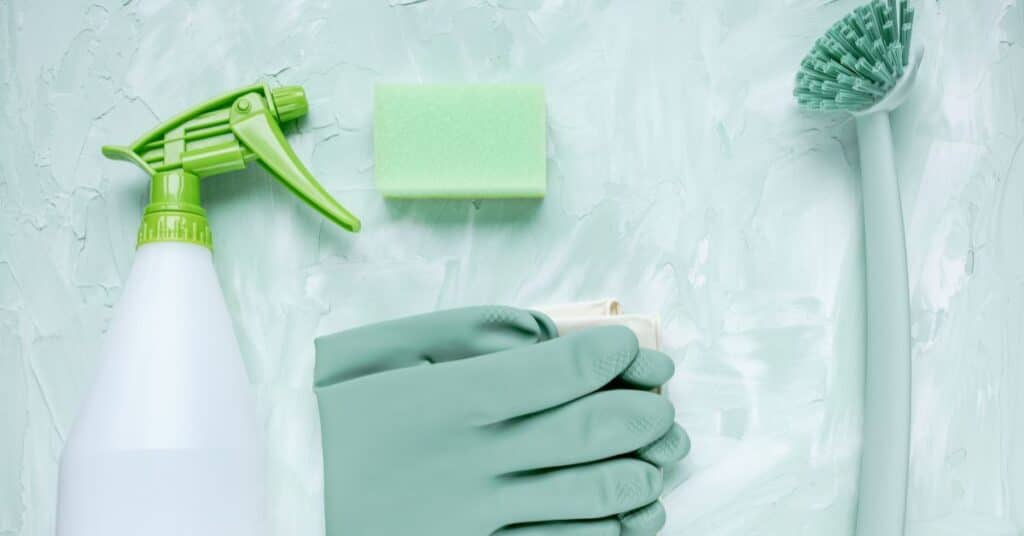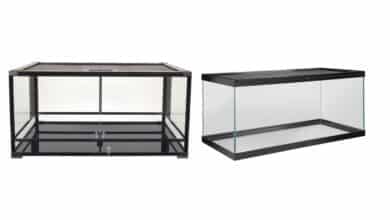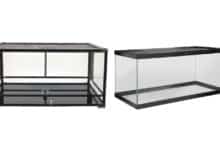How to Clean a Bearded Dragon Tank (Non-Toxic Cleaning)

Keeping a bearded dragon’s enclosure clean is essential for its health and well-being. A dirty habitat can lead to bacterial infections, respiratory problems, and other health issues that can harm your pet bearded dragon.
Cleaning your bearded dragon’s tank or terrarium on a regular basis can be a straightforward process that can be done quickly and easily with the right tools and techniques. Routine cleaning and maintenance will keep a clean tank and help ensure your bearded dragon stays healthy and live a long life.
Here is how to clean your bearded dragon’s tank and what you can do on a daily, weekly, and bi-monthly basis to maintain the tank to ensure a healthy habitat for your beardie.
Special Note: This article does have affiliate links. If you click a link and happen to make a purchase, we may receive a small commission at no cost to you. Thanks for your support – this commission helps us to continue educating the reptile community!
Contents
Getting Setup to Clean a Beardie’s Tank
Before you begin cleaning the tank, removing your bearded dragon and placing it in a safe and secure location is essential. It would be best to gather all the necessary cleaning supplies, including a scrub brush, a bucket, and a cleaning solution.
Once you have everything you need, you can start cleaning the tank by removing all the substrate, decorations, and other items. You should then scrub the tank with the cleaning solution and rinse it thoroughly with water. After cleaning the tank, you can replace the substrate and decorations and return your bearded dragon to its freshly cleaned home.
Supplies to Clean a Bearded Dragon’s Enclosure

Before cleaning your bearded dragon tank, you must gather all the necessary supplies. Here are the supplies you will need:
Rubber Cleaning Gloves
We recommend using these thick rubber cleaning gloves. They reach almost up to your elbows and will prevent you from coming in contact with both the bacteria or parasites in the tank, as well as the cleaning solutions. They also have a textured grip to be able to grab the wet, slippery glass and accessories better.
Microfiber Cloth
A microfiber cloth is an excellent tool for cleaning your bearded dragon tank. It is soft and gentle on the tank’s surfaces and won’t scratch or damage them. Use the microfiber cloth to wipe down the tank’s walls, floor, and decorations.
Scrub Brush
A scrub brush is a helpful tool for removing any stubborn stains or debris from the tank’s surfaces. Use a soft-bristled brush to scrub the tank’s walls and floor and a hard-bristled brush to clean any decorations or hide boxes.
Non-Toxic Cleaning Solution/Disinfectant
When selecting a cleaning solution, it’s essential to use a safe product for your bearded dragon that won’t leave any harmful residue behind. Avoid using any harsh chemicals that could be harmful to your pet.
Here are some safe cleaning solutions for bearded dragons:
- A mixture of water and white vinegar
- A solution of one part bleach to ten parts water
- A mix of hydrogen peroxide and water
If you would rather not have to mix a solution, then we recommend Zilla’s terrarium cleaner.
How to Clean Your Bearded Dragon’s Tank

Cleaning the Substrate
The first step to cleaning your bearded dragon’s tank is to remove your pet from the enclosure and place them in a secure location. Begin by removing and sanitizing the substrate.
Check out our complete guide on How to Sanitize Reptile Substrate.
Cleaning a Reptile Carpet
If using a reptile carpet, shake it out over a trash can to remove any loose debris. If it is heavily soiled, it should be washed in hot water and a small amount of dish soap or reptile-safe cleaner. Allow it to air dry completely before placing it back in the tank.
Cleaning the Accessories
Next, remove any decor and accessories from the tank, such as rocks, branches, and dishes. Wash them in hot, soapy water and scrub off any debris or buildup. Rinse thoroughly and allow them to air dry. If you notice any fungal growth or harmful bacteria, soak the decor in a 10% bleach solution for 10-15 minutes before rinsing and drying.
Cleaning the Glass and Inside of the Tank
Using a reptile-safe cleaner or a mixture of equal parts water and vinegar, spray the inside of the tank and wipe it clean with a paper towel or soft cloth. Use a scraper or razor blade to remove stubborn stains or buildup gently.
How Often Should You Clean Your Bearded Dragon’s Tank?
Keeping your beardie’s tank clean is essential for its health and well-being. The frequency of cleaning your bearded dragon’s tank depends on various factors, such as the size of the tank, the number of bearded dragons you have, and the cleaning routine you follow. Here are some guidelines on how often you should clean your bearded dragon’s tank.
Daily Substrate Sifting
Bearded dragons are known to be messy eaters and old food or dead insects can end up all over the tank. A healthy bearded dragon poops on a daily basis, so poop can build up quickly. Using a sifter to clean their substrate daily is the best practice.
Sift the loose substrate daily to remove leftover food, feces, or shed skin. Daily spot cleaning will prevent the buildup of harmful bacteria and parasites that can cause infections and health problems for your bearded dragon.
Daily Food & Water Dish Cleaning
Cleaning the food dish and water bowl daily helps maintain good hygiene. Food bowls are one of the places most prone to harmful bacteria and parasites due to the amount of externally sourced insects, veggies, and sometimes fruit placed in the bowl.
Remove any uneaten food and clean the dishes with hot water and soap. Use a 10% bleach solution to sanitize the dishes and rinse them thoroughly. Make sure to dry them using a microfiber cloth or air dry them completely before refilling them with fresh food and water.
Doing this simple daily task will prevent the growth of these harmful sources that can cause digestive and respiratory infections in your bearded dragon.
Weekly Cleaning Glass
Having clean glass will ensure that your bearded dragon has a clear view of its surroundings. It would be best to clean the glass of your bearded dragon’s tank once a week to remove any smudges or fingerprints. Use a vinegar solution with a soft microfiber cloth to clean the glass. The vinegar solution will prevent the buildup of toxic fumes that can harm your pet.
Bi-Monthly Tank Sanitization
You should perform a deep clean of your bearded dragon’s tank every two months. Sanitizing the tank involves:
- Removing the substrate and all accessories from the tank
- Doing a deep clean scrub of every side of the tank’s glass
- Disinfecting all of the plastic resin accessories
- Sanitizing wood accessories and the substrate
Use a solution of one cup of bleach per gallon of water with a soft scrub pad or brush to scrub down the tank’s glass and all plastic resin accessories to sanitize them. Rinse everything thoroughly. Let the tank dry completely before refilling the tank with a newly purchased or sanitized substrate. Then replace all accessories before placing your bearded dragon back in the enclosure.
Doing this deep clean sanitization bi-monthly will keep all harmful bacteria and parasites away that can cause infections and health problems for your bearded dragon.
What Not to Use
When it comes to cleaning your bearded dragon’s tank, there is specific cleaning equipment that you should avoid using. Here are some examples:
- Chemical cleaners: You should not use chemical cleaners in your bearded dragon’s tank. These cleaners can be toxic to your pet and can cause health issues.
- Abrasive scrubbers: Avoid using abrasive scrubbers like steel wool or harsh brushes. These can scratch the tank’s surface, making it harder to clean in the future and even creating a breeding ground for bacteria.
- Soap: Using soap to clean your bearded dragon’s tank can leave behind a residue that can harm your pet’s health. Soap can also be difficult to rinse off thoroughly, leaving behind a film that can harm your pet. If you use soap, then make sure to use a 10% bleach solution as another scrub-down pass on the tank, followed by a thorough rinse to remove all residue.
Instead of using these items, opt for more natural and safe cleaning solutions. Mixing vinegar and water is an effective and secure way to clean your bearded dragon’s tank. You can also use a reptile-safe disinfectant. Follow the instructions carefully and rinse the tank thoroughly before adding your pet back in.
Beardie Tank Cleaning FAQ
A bearded dragon tank should be cleaned on daily basis by sifting poop, dead insects, and old food from the substrate. On a weekly basis, the glass of the tank should be cleaned. At least every other month, a deep clean sanitization of the tank, substrate, and all accessories should be completed to keep harmful bacteria and parasites out of the habitat.
Yes, you can use soap and water to initially clean a bearded dragon tank. However, this will potentially leave harmful residue behind. To remove any residue, use a 10% bleach solution to sanitize the tank followed by a thorough rinse and a complete air dry.
When doing a deep clean of a standard 40-gallon bearded dragon tank, it can take up to an hour or two depending on the type of substrate. A loose substrate will need to be sanitized using heat which can add time to the cleaning process unless a new substrate is purchased.





